A Lesson on Tackling from Falcons' Dan Quinn

FLOWERY BRANCH, Ga. — Dan Quinn stands, hunched over the elevated desk in his office—he never sits because he doesn’t have a chair—alternating his gaze from his computer to the large television monitor at the front of the room.
“Give me a second,” he says as his guests enter. For the second consecutive training camp, Quinn has invited members of The MMQB’s NFL training camp tour bus to join him for a 30-minute coaching tutorial. He’s putting the finishing touches on his presentation.
To the right of the TV screen, there’s a framed quote from pastor and author Charles Swindoll that includes the following: “I am convinced that life is 10% what happens to me and 90% how I react to it. And so it is with you. We are in charge of our attitudes.” To the left hangs “The Tale of Two Wolves,” a parable of a Cherokee grandfather, who tells his grandson that inside each person rages a battle between a good wolf and a bad wolf. “Which wolf wins?” asks the grandson. The grandfather replies: “The one you feed.”
It’s the next-to-last day of Falcons camp, and Quinn is still wearing his practice attire: long pants and a long-sleeve shirt (despite 100-degree temps), plus a tee that features the words “I am the sword” encircling two axes.
This is a football coach, in a football coach’s office, and there’s no mistaking either.
After a moment, Quinn stands up to shake hands with his guests, then resumes his position behind his desk.
“You guys ready? Alright,” he says. “Let’s talk tackling.”
How the Atlanta Falcons Are Handling the Worst Loss in Super Bowl History
When The MMQB bus stopped in Flowery Branch in 2016, Quinn fired up tape on Keanu Neal and explained how, and why, the then-rookie safety would help elevate the Falcons’ defense.
This year, the lesson dives deeper into the basics, and that comes as no surprise. Quinn’s coaching career began as a D-line coach back in 1994—for context, a year before 2017 Falcons first-rounder Takk McKinley was born—and he remained on the that side of the ball, as an assistant or coordinator, until taking the Atlanta head coaching job in ’15.
That’s also where the Falcons must show improvement to stay atop the NFC. Its offense (save the painful second half of Super Bowl LI) lit up the NFL last season, but Atlanta allowed 30-plus points in seven games, including the 34–28 OT loss to the Patriots. The numbers likely would have been even uglier had it not been for the rapid development of Neal and LB Deion Jones, both 2016 draft picks.
So, all through the offseason program, Quinn has continued to hammer home his message.
“We talk tackling not every day, but damn near,” the third-year head coach says.
Monday Morning QB: Bucs GM Jason Licht ‘Owning Up’ to Roberto Aguayo Mistake
Quinn calls the Falcons a “leverage-tackling team. If the ball carrier is on [a defender’s] left side, tackle with the left shoulder; if he’s on the right side, tackle with the right shoulder.”
Sounds simple enough, right? It’s not.
“[It takes] about half a year” to learn, Quinn says, while pulling up a play where Neal flew downhill and tackled a player on his left with his right shoulder.
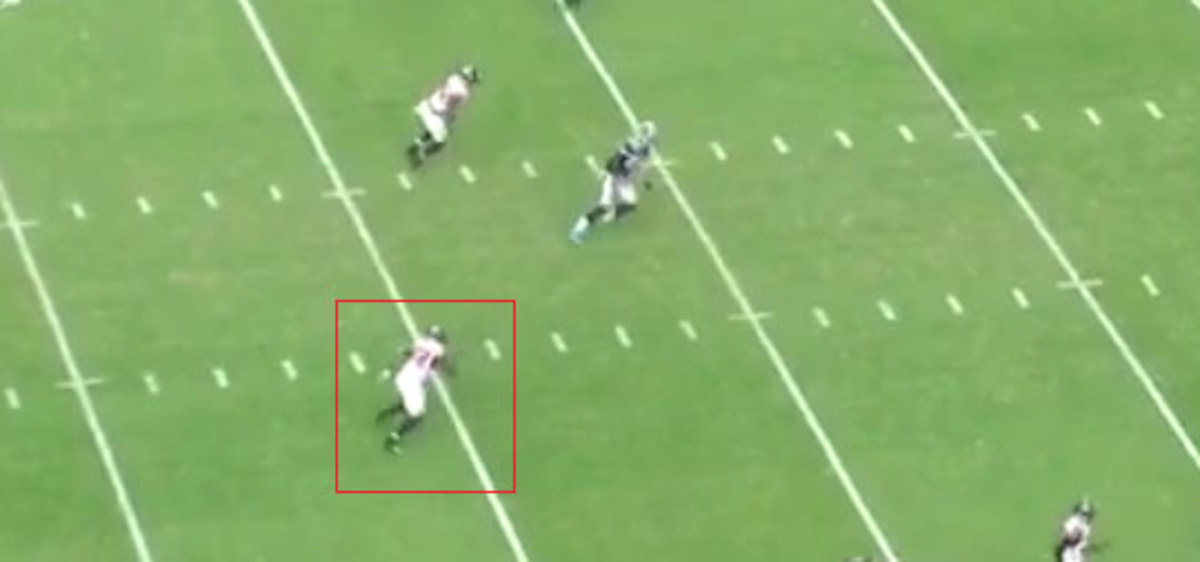
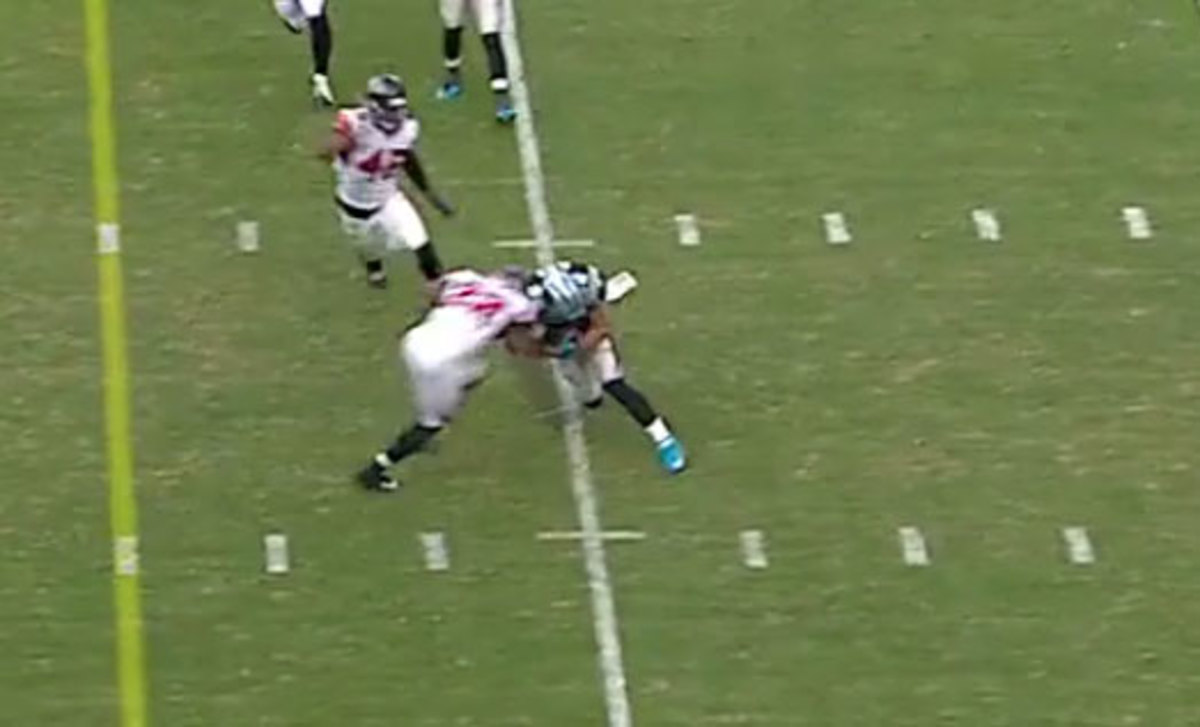
“This should be a left-shoulder hit, but his face is really in the tackle. That one to me ... I’m showing you examples of how to do it better. Keanu likes to hit on a right shoulder, but he has to be careful—if he right-shoulders there and misses, that’s an explosive play. We all have a dominant hand, you have to make sure you’re not always tackling with your dominant shoulder, make sure there’s always leverage.”
The Falcons mainly utilize a 4–3 under, three-deep zone scheme, so in an ideal setup, Quinn’s leverage strategy boxes in a ball-carrier by funneling him from defender to defender. On the screen in front of him, he runs through a series of plays from the Falcons’ 2016 season to emphasize this.
“As long as 32 keeps his leverage, he knows 59 can sprint through the hit,” he says as the next cut-up rolls, showing CB Jalen Collins (No. 32) forcing a receiver back inside so LB DeVondre Campbell (No. 59) can clean up the play. “If 32 jumps too far inside, then the runner can come too far inside. The player who’s coming [Campbell] can be a sprint tackle, but he’s got to trust that no matter what 32’s forcing the player back to him.”
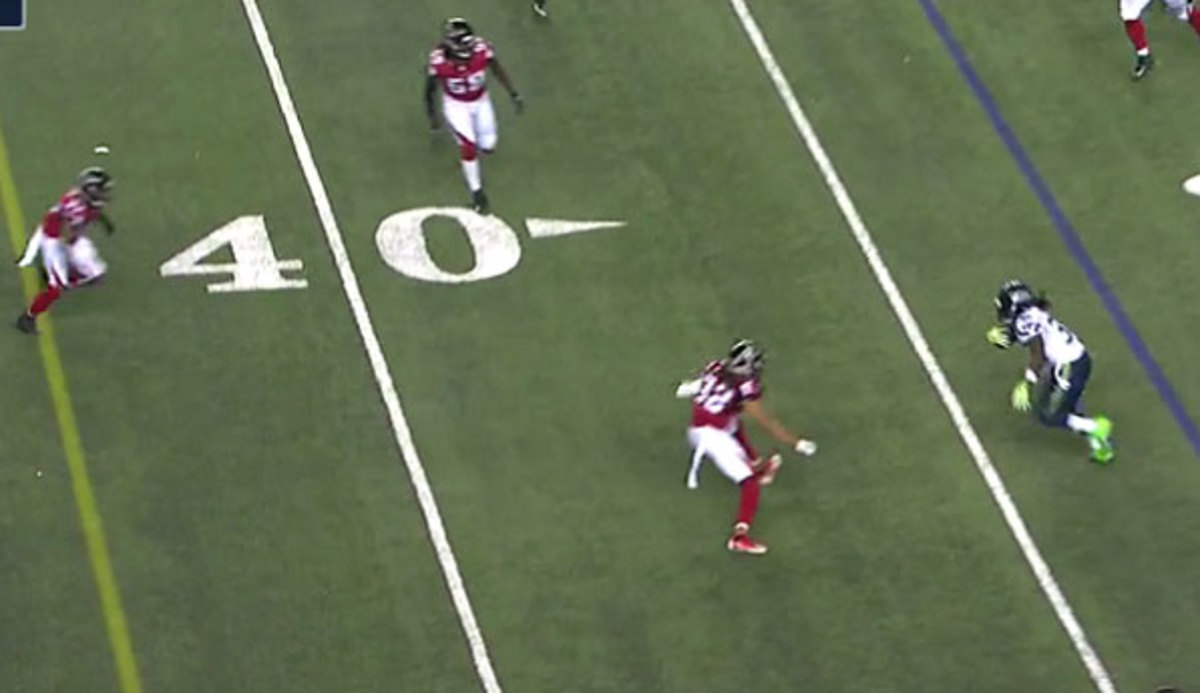
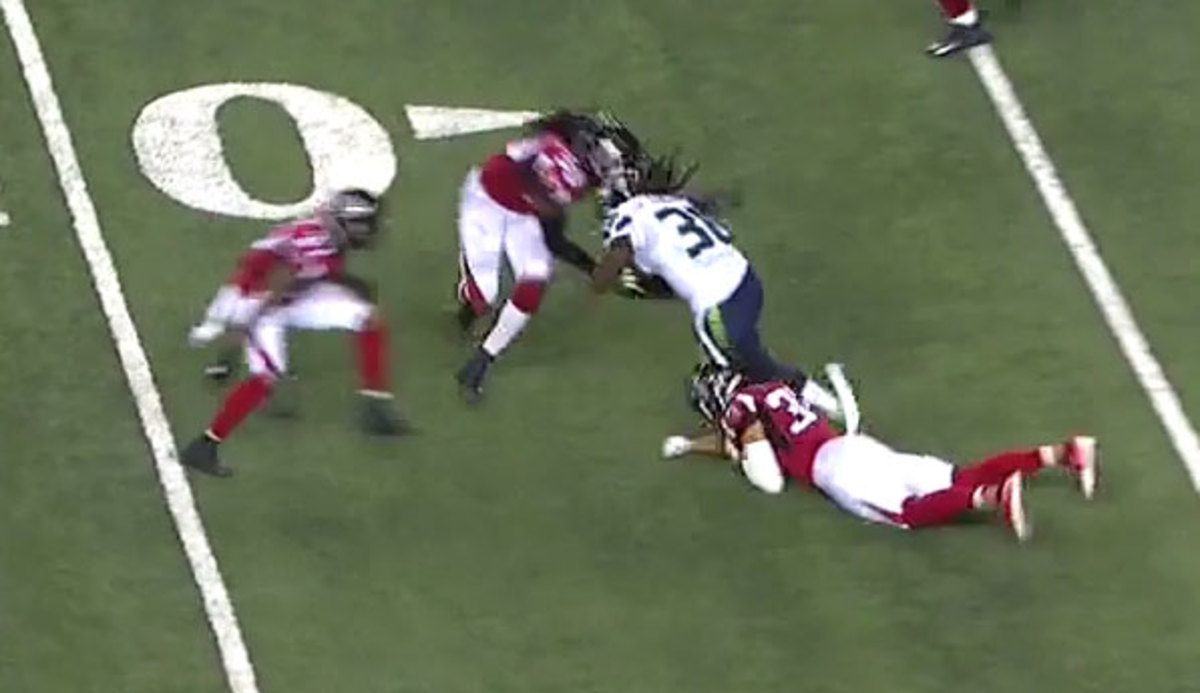
Quinn calls this ‘compression’: “When two guys have a ball carrier trapped and they make a tackle on leverage.” His follow-up emphasis is on what the Falcons have dubbed “The Secret Sauce,” a tackling method which demands players run through contact—five steps—and finish the hit.
What the Falcons want to avoid is any situation where a defender is facing a ball carrier straight on—Quinn refers to this as a “two-way go,” because the offensive player can break left or right on his choosing, rather than reacting to how the defense is angling him.
“You don’t want a guy going straight at you,” says Quinn, who then comes out from behind his desk to demonstrate. (“Come on, I’ll have you tackle me,” he instructs my colleague Tim Rohan.) “A two-way go feeling for a defender is bad. A ball carrier wants to get that, to come [straight] at you and go. Think of all the slot receivers, Wes Welker, he was trying to get to heads up on a guy.”
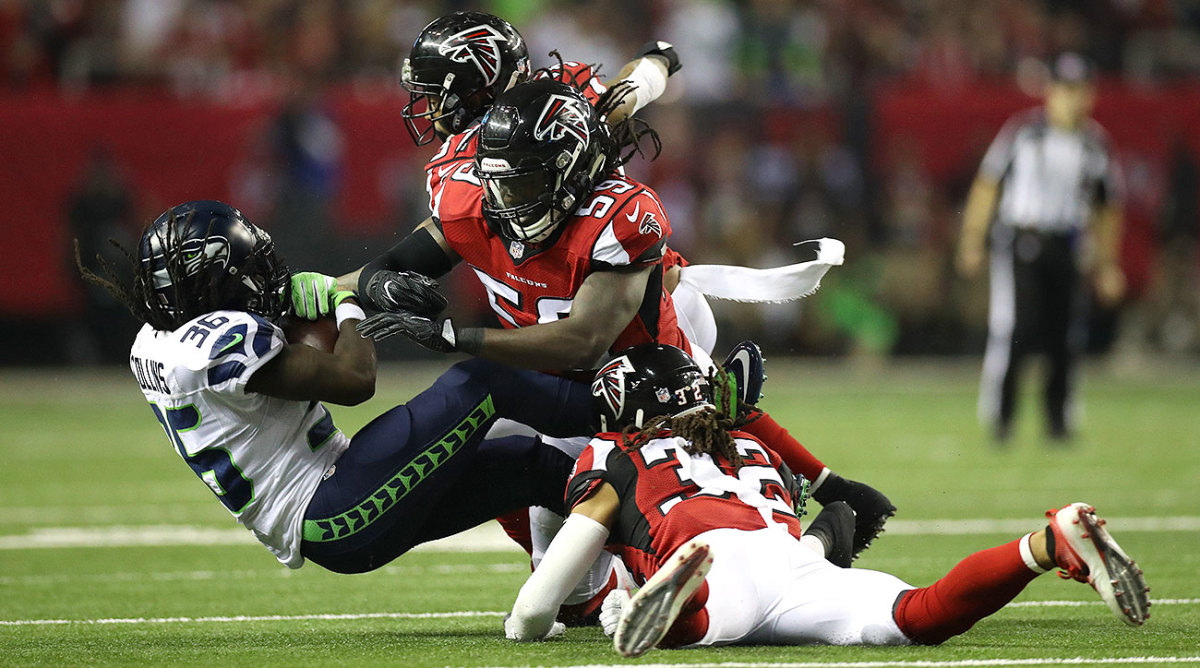
The obvious reason that Quinn sells his “leverage” system is that he believes it works. During his two seasons as defensive coordinator in Seattle (2013–14), the Seahawks twice led the league in points allowed en route to back-to-back Super Bowl trips (one win, one loss on Malcolm Butler’s goal-line interception). That was Quinn’s second stint with the Seahawks—he was assistant head coach/D-line coach from 2009–10—and he also made stops with the 49ers, Jets, Dolphins and University of Florida.
The other factor in this approach for Quinn? Player safety. The first slide Quinn puts up includes a “strike zone” graphic—he wants his players to focus on a knees-to-shoulders range, similar to what technically constitutes a strike in baseball. “We are throwing strikes, but fastballs,” he says later during his presentation.
Doing so is meant to help with the leverage approach, but also to keep any dreaded helmet-to-helmet contacts out of the equation. “Through the years we’ve done a lot of rugby tackling to talk the technique,” Quinn says. “I thought their sport has done a good job of keeping the head out of the hit. ...
“We want to hit the strike zone lower than the ball carriers’ shoulder pad,” he adds. “We want to hit with a rising blow where we’re coming up through a guy instead of just catching him.”
The Falcons invited local college and high school coaches to their earlier OTAs. ”I like them to see how we’re teaching tackling without pads, how we’re teaching concepts,” Quinn says. During Sunday morning’s practice, prior to his invitation-only lecture, a professional women’s football team takes in the Falcons’ two-hour workout.
“Ten years ago, it felt like youth football was taking a hit,” Quinn says, “and I feel it’s turned the corner now where it’s back really safe, the teaching. That part, I want the parents to know that people are putting in the time to each the game safely for their sons and daughters.”
As noble as that cause is, Quinn’s job—like that of every coach in the NFL—hinges on wins and losses. The Falcons claimed 11 of them during the 2016 regular season, plus an NFC title, on the strength of its league-best offense.
The defense remains remarkably young—at least eight of the Falcons’ projected defensive starters have entered the league between 2013 and now. Bump that total to 10 if McKinley and fellow rookie Duke Riley manage to crack the first team. Quinn and the front office have emphasized speed, first and foremost, when finding all those prospects, but a great deal of effort also goes into whether or not a player’s mindset fits the Falcons’ mold.
And fusing all those inexperienced players together poses a mountainous task. The flip side, though, is that Quinn can mold those newcomers in the Falcons’ desired image.
“It’s tougher for that [veteran] player,” Quinn says, “because they’ve had a lot of years ingrained in them and can say, ’I’ve made my living playing this style.’ For the college guys coming in, they’re pretty apt to get it done how you want it done. They’re trying to put their best foot forward.”
No matter the age, everyone who arrives in Atlanta is expected to buy in to Quinn’s system, even if it does require a little tear down and rebuild. It’s an ongoing process, for player and coach. Quinn’s 30-minute Sunday film session barely scratches the surface of all that’s involved.
“It’s not as difficult as you think as long as you’re drilling it and drilling it,” Quinn says. “I think if you did not have a plan as far as how to tackle, it would be really difficult.”
